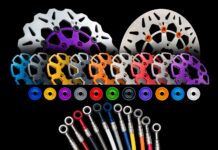Twinshot Adjustable CV40 Fuel Control
Boyesen Engineering
$179.95, polished aluminum or matte black
www.boyesen.com
800.441.1177
About a year ago, I’d installed Boyesen Engineering’s Power X-Wing, a bolt-on airflow performance product that claimed to increase horsepower and torque. The product did indeed show increases in both these numbers on my carbureted 2000 FXD, so when I learned of Boyesen’s new Twinshot Adjustable CV40 Fuel Control product, I decided to try it as well.
The Twinshot is an adjustable fuel delivery system intended to deliver gasoline to the carburetor in a more consistent, controlled fashion than is possible with the stock Keihin CV unit installed on carbureted Harley-Davidsons manufactured between 1992 and 2006. The first component in the Twinshot system is a new float bowl designed to accommodate the other elements in the kit. During a visit to Boyesen Engineering’s facility in Lenhartsville, Pennsylvania, the crew showed me several float bowls for the Keihin CV-40s that Harley-Davidson had designed and manufactured during these model years, and each had different locations where the fuel enters the accelerator pump cover. So, Boyesen came up with a standardized float bowl as part of the Twinshot kit.
Inside Boyesen’s float bowl is a precisely-aligned twin-hole sprayer, hence the name “Twinshot.” Boyesen claims that two smaller holes, rather than the stock single hole, creates a finer spray that produces more velocity, improving fuel atomization. It’s removable and angled in a way that makes it easier to clean. There’s a dual check valve system (most CV-40s have only a single system) that holds pressure in the accelerator pump circuit. One of the check valves is located near the sprayer for more immediate throttle response.
Boyesen also includes a five-percent stiffer activation spring to reduce lag time when the rider cracks the throttle. The company also incorporates a standard-length accelerator pump plunger rod to address inconsistencies in fuel spray action caused in part by variances in stock plunger rod lengths.
What I found to be a useful feature of the Twinshot is the removable main jet cap that allows you to change the main jet without taking the float bowl off. It would’ve been useful to also gain access to the slow jet in the same manner; however, there isn’t enough room in the float bowl to place another removable cap. Besides, even with a removable cap, Boyesen believes that for the everyday rider, it’s pretty difficult to access the more deeply-recessed (and smaller) slow jet without stripping it or getting it stuck, necessitating the removal of the float bowl anyway.
The niftiest feature, though, has to be the adjustable leak jet. The stock leak jet is fixed (nonadjustable), meaning that you cannot control either the amount or duration of fuel sprayed into the carb. At the bottom of the Twinshot in an easy-to-reach location is a thumbscrew controlling the leak jet. This comes in handy when you ride your bike at a different altitude than it’s been tuned for, or even when the ambient temperature changes. By turning the adjuster screw in (clockwise), you force more fuel into the carb. And by turning it out (counter-clockwise), the fuel flow will be leaner. Because the screw is so easy to access, you can make on-the-road adjustments instead of having to change jets.
The entire Twinshot kit is a bolt-on replacement of the stock fuel bowl, and takes only about a half-hour to install—air cleaner off, carburetor pulled out and float bowl replaced. I tried it first on my Sportster because the bike often bogs down for a second or two when I snap the throttle, sometimes to the point that I think it’s going to stall. (The hot cams and high-compression pistons combined with a sticky carburetor slide most likely contribute to that condition.) I set the adjustable leak jet to the default setting in the middle position (four complete turns of the screw are possible, so I set it at two).
Although the Twinshot didn’t eliminate the hesitation, it reduced it substantially, along with providing quicker and smoother throttle response throughout my normal rpm range. Not being sure that the leak jet’s middle position was optimal for the Sportster, I experimented by turning the screw out until the pipes popped from a too-lean condition.
Encouraged by the results, we installed the Twinshot on my Dyna which was running quite lean. I like the high mileage that I get—at least 50 mpg in most situations—but the price I pay is the exhaust pipes popping when the bike backs down, especially when I drop the throttle quickly. Sure enough, the Twinshot helped with the backdown popping (to eliminate it entirely, I’d probably have to change the fuel/air mixture and maybe the jetting). And the improved throttle response was even more pronounced than on my Sportster, bringing it closer to what’s offered by Harley’s fuel-injected systems. Results weren’t proven by doing dyno runs or any other scientific measurements, but my seat-of-the-pants tests indicate that the Twinshot works as advertised.
Replacement parts are available from Boyesen, and the Twinshot is unconditionally guaranteed.
Boyesen has taken its 35-plus years of performance engineering and intake manufacturing for powersports and other vehicles, including racing applications, and applied this experience to the American V-twin industry. So if you’re looking to improve throttle response on your carbureted Harley, the product is worth a shot—a Twinshot, that is…



















